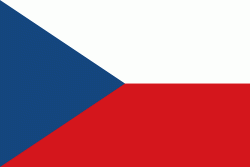Czech koruna
KÄ
The koruna, or crown, (sign: Kč; code: CZK, koruna česká) has been the currency of the Czech Republic since 1993. The koruna is one of the European Union's 8 currencies, and the Czech Republic is legally bound to adopt the euro currency in the future.The official name in Czech is koruna česká (plural koruny české, though the zero-grade genitive plural form korun českých is used on banknotes and coins of value 5 Kč or higher). The ISO 4217 code is CZK and the local acronym is Kč, which is placed after the numeric value (e.g., "50 Kč") or sometimes before it (as is seen on the 10-koruna coin). One crown is made up of 100 hellers (abbreviated as "h", official name in Czech: singular: haléř, nominative plural: haléře, genitive plural: haléřů – used with numbers higher or equal to 5 – e.g. 3 haléře, 8 haléřů), but hellers have now been withdrawn from circulation, and the smallest unit of physical currency is 1 Kč.
In 1892, the Austro-Hungarian crown replaced the florin, at the rate of one florin to two crowns (which is also the reason why the 10 Kč coin had been nicknamed pětka or "fiver" - and has been in use in informal conversation up until nowadays). The name was suggested by the emperor, Franz Joseph I of Austria. After Austria-Hungary dissolved in 1918, Czechoslovakia was the only successor state to retain the name of its imperial-era currency. In the late 1920s, the Czechoslovak crown was the hardest currency in Europe. During the Second World War, the currency on the occupied Czech territory was artificially weakened. The Czechoslovak crown was restored after the war. It underwent a highly controversial monetary reform in 1953.
The Czech koruna replaced the Czechoslovakian crown when it was introduced in 1993 after the dissolution of Czechoslovakia. It first consisted of overstamped 20 Kčs, 50 Kčs, 100 Kčs, 500 Kčs, and 1,000 Kčs banknotes, and a new series was properly introduced in 1993.
In November 2013, the Czech National Bank (ČNB) intervened to weaken the exchange rate of the koruna through a monetary stimulus to stop the currency from excessive strengthening. This was meant to support the Czech economy, mainly focused on export, but people were unhappy about this step because it was set up before Christmas, which led to raising the prices of imported goods. In late 2016, the ČNB stated that the return to conventional monetary policy was planned for mid-2017. After higher-than-expected inflation and other figures, the national bank removed the cap at a special monetary meeting on April 6, 2017. The koruna avoided significant volatility and City Index Group stated: "If you want to drop a currency peg, then the ČNB can show you how to do it".
Country
-
Czech Republic
The Czech Republic, also known as Czechia, is a landlocked country in Central Europe. Historically known as Bohemia, it is bordered by Austria to the south, Germany to the west, Poland to the northeast, and Slovakia to the southeast. The Czech Republic has a hilly landscape that covers an area of 78871 km2 with a mostly temperate continental and oceanic climate. The capital and largest city is Prague; other major cities and urban areas include Brno, Ostrava, Plzeň and Liberec.
The Duchy of Bohemia was founded in the late 9th century under Great Moravia. It was formally recognized as an Imperial State of the Holy Roman Empire in 1002 and became a kingdom in 1198. Following the Battle of Mohács in 1526, the whole Crown of Bohemia was gradually integrated into the Habsburg monarchy. The Protestant Bohemian Revolt led to the Thirty Years' War. After the Battle of White Mountain, the Habsburgs consolidated their rule. With the dissolution of the Holy Empire in 1806, the Crown lands became part of the Austrian Empire.
